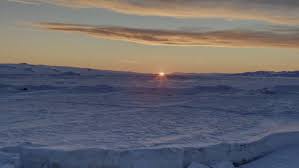The long night in Antarctica ended with sunrise on the horizon as researchers resumed their work on various scientific studies in the region.
In the frozen landscape there are research stations from different countries, which are now being prepared for the summer and the return of the arriving scientists for the warmer months from November. The long night, which lasts between four and five months and is characterized by 24 hours of darkness, locks the researchers on a continent known for one of the most extreme environments on earth.Nick Smith of ESA has overseen experiments in human biology and physiology, atmospheric physics, meteorology and astronomy.Along with the rest of the crew, he also maintains the base, one of only three that operate in Antarctica all year round.
When the sun rises again in the region, bases are cleaned and machines are serviced, tents are set up and heated, and snow is cleared from the runway so that new crews can arrive
The long dark period in Antarctica is considered a gold mine for research, as people prepare for long-term flights into space and plan manned missions to the moon and Mars. "Four months of total darkness is quite a challenge and the researchers are keen to study from a physiological and psychological perspective," ESA said in a statement. While examining the behavior of the body during the long darkness, the social dynamics during the dark are also explored.




The Brief. Sign up to receive the top stories you need to know right now.